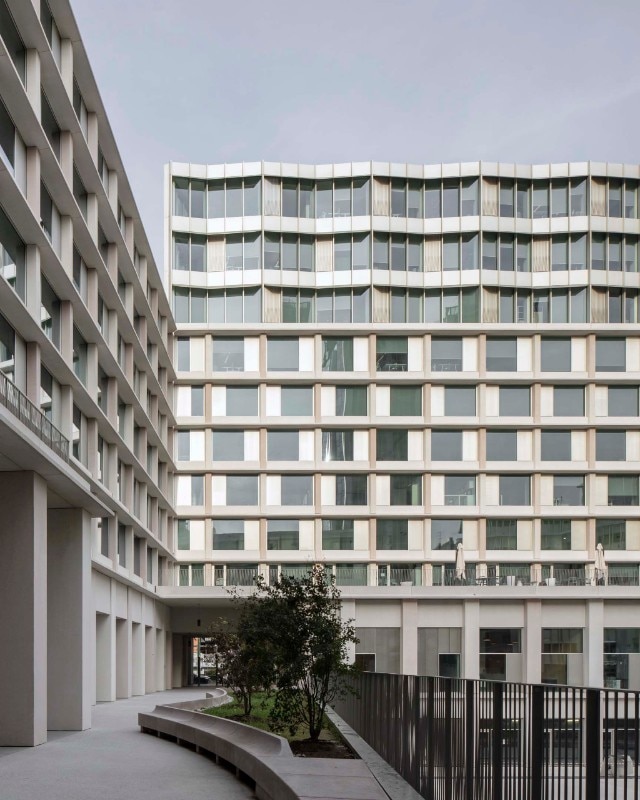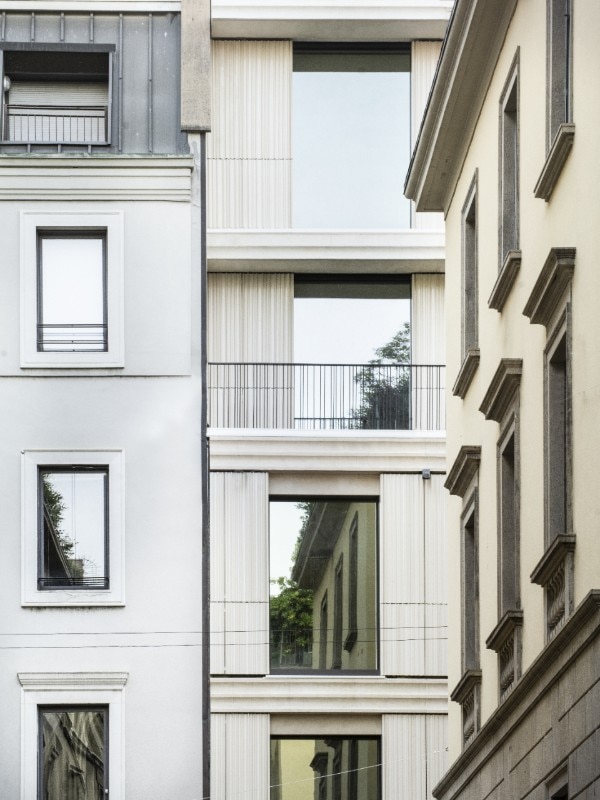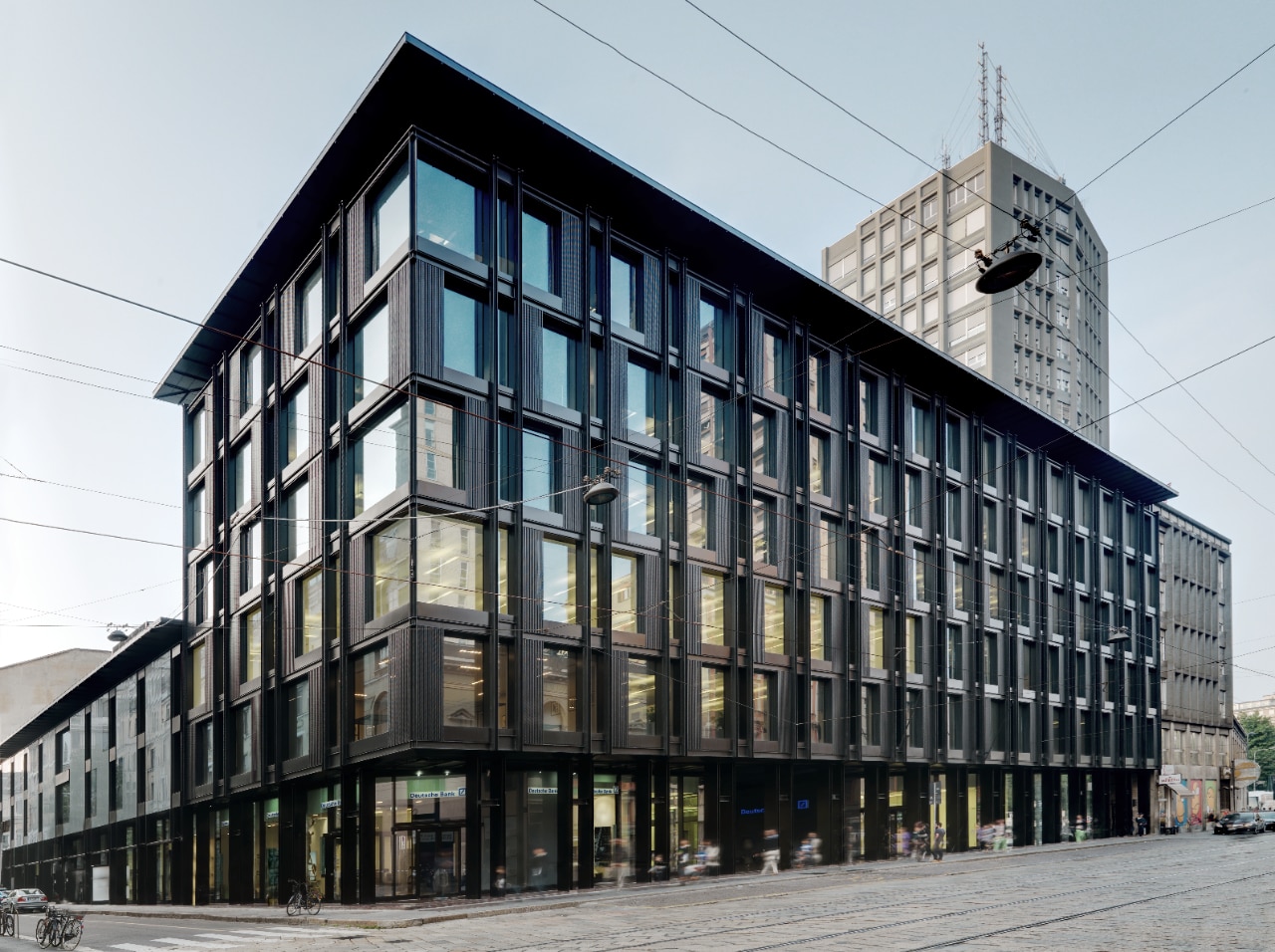In West Milan, near the suburban downtown of CityLife, Piuarch will renovate a 1950s office building, whose outside was already clearly altered in more recent times. The project of this Milan-based firm – “Ivory” according to its trade name – seems to be overall proper, pleasant, and contemporary; it was its presentation to the press what offered a point of reflection on the office building of the 20th and 21st centuries.
Some clues suggest the existence of a well-spread awareness of the historical and cultural value of modern residential Milan, as well as its newfound coolness. A proof of this is the success some excellent publications had in recent years, among which the popular 2017 Entryways of Milan by Karl Kolbitz (Taschen) and Case Milanesi 1923-1973 (Milanese Houses 1923-1973) by Simona Orsina Pierini and Alessandro Isastia (Hoepli). And Nelle case. Milan interiors 1928-1978, also by Orsina Pierini with Enrico Morteo (Hoepli), has just been published. These books stem from a decade-long process of studying and reevaluating residential buildings erected in Milan in the 1950s and 1960s.

Milan offices: a transforming old landscape
Office buildings from that same time period, however, seem to be still waiting for their rediscovery. Of course, works by major architects, Gio Ponti first of all, and the few 1900s skyscrapers of Milan, with Pirelli and Galfa in the lead, have regularly been featured in stories and guides on architecture. On the other hand, many other “minor” office buildings stayed in the shadow despite being a crucial element in the transformation of Milan in the decades following World War II. At the same time, the retrofitting trend – a technological upgrading with the goal of improving the energy performances and regulatory compliance – that started at the end of the 2000s emerges as a widespread practice that, inevitably, had significant effects even on the more architectural, linguistic, and material aspects of the affected buildings.
The ordinary landscape of the modern buildings in Milan has been gradually disappearing or, at least, has been experiencing profound changes. We do not intend to cry scandal nor rally the architectural culture and public opinion for its rescue. Rather, we are interested in elaborating a few thoughts about its effects and the modalities of a process that has been ongoing for at least fifteen years.

Retrofitting Milan: aesthetics and geography
At the moment, the results are quite uneven. We count sad “losses,” for example the former office building Tecnimont by Claudio Longo and Giulio Ricci (1970-1975), which was irreparably compromised by the renovation oversaw by Gbpa’s architects with Tekné (2017), which dematerialized with a banal transparency the powerful shell of continuous self-supporting and prefabricated walls in anodized aluminum and crystal. On the other hand, we note the remarkable level of sophistication and sensitivity to the existing original in interventions such as that of Park Associati on the former Campari headquarters designed by the Soncini brothers on via Turati (1962), which did not make us regret losing the original curtain wall.
The geography of Milan’s retrofitting has already been outlined. Logically, redevelopment is more frequent where the stock of 1950s and 1960s office buildings – but also from the 1970s, 1980s and 1990s – is more concentrated.
Lastly, we suspend judgment on the projects that so far have only been announced: in August 2023, it was announced that Asti Architetti will oversee the renovation of Vico Magistretti’s building on Corso Europa (1957), a quite famous building that has already undergone many unfortunate alterations.
The geography of Milan’s retrofitting has already been outlined. Logically, redevelopment is more frequent where the stock of 1950s and 1960s office buildings – but also from the 1970s, 1980s and 1990s – is more concentrated. In particular, the places where to test the scope of this ongoing transformation brought to urban scale are the streets around Porta Nuova and Porta Garibaldi, where the fragments of the unfinished Centro Direzionale and of the post-war axis of Via Vittor Pisani are scattered.
Even in these hotspots, the many anonymous interventions have been layered on top of equally unexciting preexisting structures and only sometimes interspersed with some quality work. For example, Onsitestudio oversaw the renovation of two former hotels that stand out for their rigor and the elegance of the details of their redesigned façade grids: the Executive on Via Sturzo (1972), which was turned into the office complex The ED.GE (nearing completion) and Mario Bacciocchi’s Duca d’Aosta (1953, completed in its new guise in 2015), facing the Duca d’Aosta square, which was kept as a hospitality facility. However, beyond the fate of the individual buildings, visiting the neighborhoods around the northern bastions gives a quite clear idea of the ongoing redefinition of the overall image of some parts of the city.

The collective construction of an urban landscape
To conclude, there is chronological overlap between the spread of the retrofitting practice and the establishment of small groups of Milan-based professional firms, all founded at the turn of the millennium by partners born in the 1960s and 1970s. In addition to Onsitestudio and Piuarch – which before Ivory had already renovated and designed ex novo various office complexes for Dolce & Gabbana in Milan – there are Park Associati – their Valtorta 52 in Turro (2002) is worth mentioning – and Scandurra Studio Architettura, which has recently transformed a gray 1950s complex into the Spiga 26, a building that fits in its historical context even better than the original. All these firms have an ample and varied production even in other areas, but the realization of office buildings in Milan in the 2010s and 2020s, often as a result of a retrofit of preexisting buildings, was the source of frequent important commissions, which have also allowed the firm to move onto a bigger scale. At the same time, these Milan-based architects, who have often been trained at the local Politecnico university, have proven to be quite virtuous in this field.
The ordinary landscape of the modern buildings in Milan has been gradually disappearing or, at least, has been experiencing profound changes.
Their collective action has been outlining a new office scene in Milan, an alternative view in respect to that of the skyscrapers designed by international archistars, a scene that is still evolving and of which the Ivory represents the latest addition. In the moment in which these firms have access to larger commissions and higher ambitions – for the past few months, Park Associati has been working on the Palazzo Sistema of the Regione Lombardia and at the MI.C. tower, near the Central Station, while Piuarch has been working on the Human Technopole Headquarters & Campus at the 2015 Expo area – the times are ripe for systematic study of the city’s landscape capable of showcasing the recurring characteristics and specificities, qualities and issues, of an abundant and ripe genealogy of 21st-century offices.


















